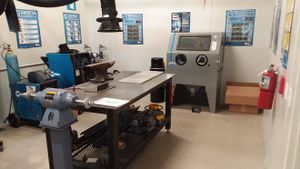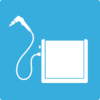Welding Shop
The Welding Lab has multiple welders including a TIG, MIG and Plasma cutter. The welding shop consists of a 280 sq. ft room. It contains a Welding Table, MIG Welder, TIG Welder, Spot Welder, Plasma Cutter, Blasting Cabinet as well as a Fume Boom for ventilation. There is a first aid kit located on the east wall. One of the first things you should do when walking into the lab is turn on the fume extractor and light switch. When you leave the space make sure to turn off all the machines, close all gas valves and reset the space.
The current Aces of the Welding Shop are Wyatt Bertis (wbertis22@georgefox.edu).
Schedule
The welding shop is open by appointment only. Please email Makerhub@georgefox.edu for an appointment.
Equipment Overview
| Name | Company | Model | Current Ace ⠉ |
|---|---|---|---|
| Blast Cabinet | Skat Blast | SC-40 | Needed |
| Buffers | Baldor | 332B | Needed |
| MIG Welder | Miller Electric | Millermatic 210 | Wyatt Bertis |
| Pedestal Grinder | Baldor | 332B | Needed |
| Plasma Cutter | Miller | Spectrum 875 | Needed |
| Spot Welder | Miller | LMSW-52 | Needed |
| TIG Welder | Miller | Syncrowave 250DX | Wyatt Bertis |
Equipment by Icon
3 commandments
1. Safety First
Safety First is the rule we hold highest of the three. This rule applies to both the safety of you as well as others.
Keeping yourself safe in the Welding Lab is very important, as there are possibilities for accidents if you don't follow the safety guidelines. The following rules must be followed at all times.
- Safety glasses must be worn at all times.
- A face shield is required when operating the pedestal grinder.
- When producing sparks pay attention to their direction.
- Never stand on or kink any of the equipment leads.
- No horseplay in the shop.
- Don’t do anything distracting to yourself or others while operating equipment.
- Do not wear any loose clothing, jewelry, or lanyards.
- No open toed shoes.
- Hair will not extend bellow the collar.
- Gloves and helmet must be worn when welding is in progress.
- No bare exposed skin when welding or cutting. Leather welding jacket is to be worn if welding or cutting.
- Food or drink is not allowed in the Welding Lab.
- Do not attempt to operate equipment that you have not been certified on by GFU engineering personnel.
- Do not argue with volunteers or shop staff. Contact Justin Johnson if you have issues that need to be resolved.
- Do not operate welding equipment without a buddy present. Never operate equipment alone in the shop.
- Reset the space. A clean space is a safer space.
- If you see a safety violation inform the person immediately and encourage them to comply with the policies.
- Don’t do anything that would require an additional rule to be added to this list.
2. Reset the Space
The Welding Lab has a specific organization to it. Put whatever you use back where it belongs. There is a place for everything and everything has a place. This rule applies to everything in the space. If you use a tool, put it back. If you use a pen, put it back. Do not leave your projects in the Welding Lab unless you have made prior arrangements. Throw away your trash and recycling.
Now, we understand that sometimes you need to leave projects out. Maybe you are in the middle of a large project and you need something left overnight. In cases like this, it is okay, but you NEED to make prior arrangements with Nick or Justin.
Please put back the equipment the way you found it. Make sure the welding gas is SHUT OFF. The welding cables should be neatly wrapped back onto the welders after they have been allowed to cool. Never step on or kink the welding cables and lines.
Always put any unused materials back on the storage shelf, and throw away unusable scrap.
Sweep the floor and welding table when done.
Make sure to shut off the lights and room ventilation before leaving.
Always leave the space better than you found it.
3. Be Professional
This commandment has two sides to it. It covers the idea of acting like professional (which Webster’s defines as “exhibiting a courteous, conscientious, and generally businesslike manner in the workplace”). The term also describes the standards of education and training that prepare members of the profession with the particular knowledge and skills necessary to perform their specific role within that profession. Hopefully, you are learning both of these as part of your education at George Fox University. In the Welding Lab we expect you to develop as a courteous, conscientious, and skilled craftsman, understanding the tools and equipment in the Maker Hub and how to use them effectively.
Being a professional has some obvious ramifications in terms of behavior. First, be Christlike. Think of others better than yourselves. Share. If you have been welding for a prolonged time and someone else is waiting for the machine, let them use the machine for a while. This is being a professional.
If you are learning to weld, and you can't get something to work the way you want - ASK SOMEONE! Learn! Become a professional. Learn the craft. This is an educational space. You might think it will be quick and you can just get it done “your” way and not learn how to do it correctly. Be a Professional and learn the proper way, and then be available to teach others.
One very important, and likely difficult part of being a professional is to correct others when they are not being professional. It is your responsibility to speak up when you see somebody doing something inappropriate. If you see somebody doing something unsafe, not resetting the space, or being unprofessional, the professional thing to do is to remind them of the three commandments and ask them politely to correct their action. This is OUR space, not any individual's. As a group, we expect everyone in the space to keep the space safe, clean, and operable for everyone.
If someone acts disgracefully unprofessional to you in the Welding Lab, you are welcome to bring the issue to Justin or Nick's attention.
General Welding Knowledge
Welding is the process of joining metals together. It is a form of additive manufacturing. There are several different types of welding, and the Welding Lab uses most of these including spot welding.
In the Welding Lab, metals are joined together using MIG (Metal Inert Gas), TIG (Tungsten Inert Gas), Stick and spot welding.
Each welder has its own special purpose and benefits. MIG is fast and much easier to learn than TIG welding. Spot welding is only used with sheet metal. TIG welding produces very clean welds and the heat is more confined to a smaller area. TIG will also allow you to weld very thin metals.
These are a few good steps to having a successful weld.
- If you experience a fire alarm while working in the Welding Lab turn off the welder power/exhaust fan if you safely can and proceed to the nearest safe exit.
- Make sure the materials have no coatings. Welding of some coatings like cadmium plating or galvanized metal can produce toxic fumes that could be fatal.
- Argon acts as an asphyxiant and will displace oxygen. Do not work in a confined space with argon do to the possibility of a low oxygen condition.
- When setting gas pressure for any of the welders make sure you follow the recommendations listed.
- Materials should be properly prepped and clean for best results.
- Make sure the process you are using is correct for your material type.
- Double check the weld settings and use a piece of scrap to practice before welding on your project.
- Only weld steel and aluminum. Do not attempt to weld unknown materials.
Here are a couple things to keep in mind:
- Material will be very hot after welding so always think before touching.
- Make sure the welder is properly grounded before attempting to weld.
- Never weld in wet clothes or around water.
- Never try to weld any type of tank that has ever held flammable liquids. This is very dangerous and can explode!
- Always check your welding hood settings prior to welding. (start with a darker setting and work your way down.
- Welding takes lots of practice so don't be afraid to ask for help.
General Bead Blasting Knowledge
Bead blasting is the process of using compressed air to propel small glass beads for ablating and cleaning a material surface. Different types of blast media are used in industry including Soda, Walnut shells, Sand and many more material types.
These are a few good steps to having Success with glass beading.
- Make sure the material is free from heavy grease and dirt.
- The material needs to physically fit into the blast cabinet.
Here are a couple things to keep in mind:
- Never point the nozzle at the gloves or window.
- Make sure the power switch is turned on before use.
- Always wait 5 minutes after use before opening the cabinet door. This gives some time for the dust to settle.
- Never try to bead blast anything flammable. Blasting can sometimes create sparks.
- Keep liquids out of the cabinet.
- Never activate the foot pedal with the cabinet door open.
Canvas Certification
Before working with any of the equipment in the welding shop you will need to take the general lab quiz as well as the specific quiz for each machine you are trying to use. The enrollment code for all of the quizzes is MakerHub.




